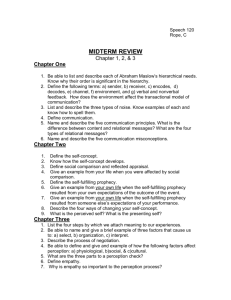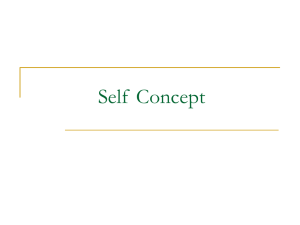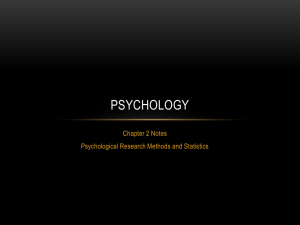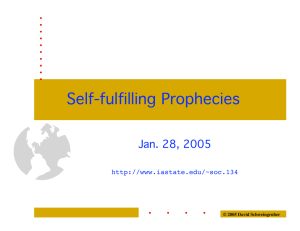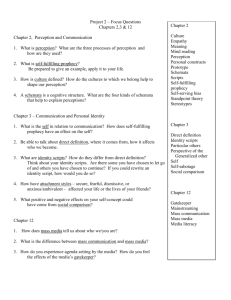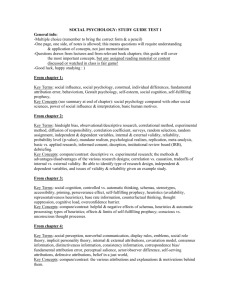by
advertisement
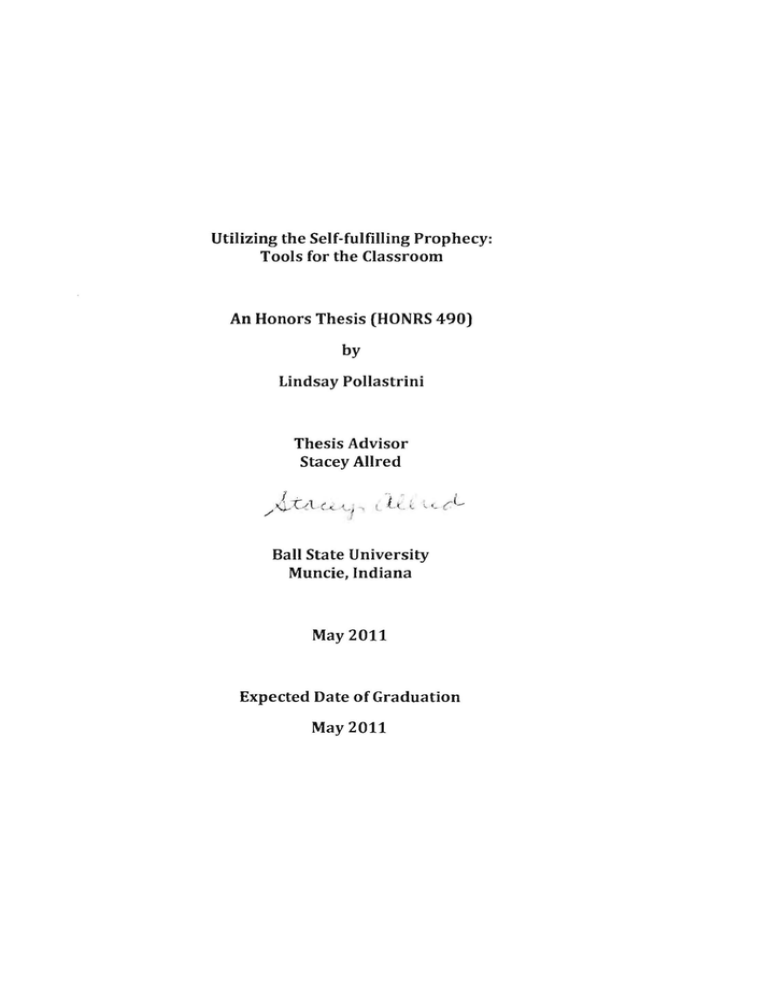
Utilizing the Self-fulfilling Prophecy: Tools for the Classroom An Honors Thesis (HONRS 490) by Lindsay Pollastrini Thesis Advisor Stacey Allred . ' i .. L ~" " L' . , /' l_ '-L Ball State University Muncie, Indiana May 2011 Expected Date of Graduation May 2011 Q Abstract • The self-fulfilling prophecy is an important aspect of education that every preservice and in-service teacher should be aware of. When teachers make expectations, they are conveyed to the students through numerous factors. The selffulfilling prophecy is defined by Edward K. Merton to be "a false definition of a situation evoking a new behavior which makes the original false conception true" (Tauber, 1997). The expectations that teachers form are based upon a student's race, gender, socioeconomic status, body build, attractiveness, ethnicity, special education labels, surname, dialect, and past school experiences or records. There have been numerous studies over the years that have shown the positive and negative impacts that these expectations have on children. It has also been proven that teachers who are educated about the self-fulfilling prophecy and how to successfully manipulate it can greatly improve student academic success. There are five critical steps in which a teacher's expectations impact a child through climate, feedback, input, and output. Some ways that teachers can use the self-fulfilling prophecy to help students believe in themselves include leveling the playing field, changing what they can for the students and themselves, and treating students with respect. Acknowledgements I would like to thank Professor Stacey Allred for all of her help as advisor during my senior honors thesis. Her guidance and enthusiasm were the driving forces in my completion of this paper and PowerPoint. Without her, I would have been lost in my journey of completing my thesis on the self-fulfilling prophecy. Author' s Statement While researching possible thesis topics, I knew that I wanted to focus on something that pertained to my major. Since I am a dual major in Elementary and Special Education, I reflected on subjects that had greatly interested me in previous courses. In particular, the topic of self-fulfilling prophecy had a recurring presence throughout my studies. Whenever I learned about self-fulfilling prophecy, I was very interested in the effects that teachers had on the outcome of a student's performance. I wanted to learn more about the reSUlting effects of teacher influence on how students view themselves and in turn how this affects their achievement. This project helped me to build my knowledge of a subject that is important to my major. Once having completed my research, I used the information that I learned to become a better teacher and helped educate other teachers as well. After learning about the self-fulfilling prophecy, I will be able to use my knowledge to influence children to perform better, achieve higher grades, and have a more favorable outlook on themselves. The greater my knowledge base, the more tools I will have in aiding children to obtain a healthier view. After I had conducted my research, I made a PowerPoint outlining the information that I learned in order to educate pre-service teachers. I presented this PowerPoint to three college classes taught by my thesis advisor. In addition to the presentation, I wrote a detailed paper about the self-fulfilling prophecy, the research proving its validity, the steps that occur in the formation of the prophecy, and how to use this knowledge to the benefit of students. Utilizing the Self-fulfilling Prophecy: Tools for the Classroom By Lindsay Pollastrini The self-fulfilling prophecy should be a term that every teacher knows. This theory has been proven through science and experiments and can be used to either build children up or knock them down. Children are very impressionable young individuals, and what they see conveyed to them is believed to be the truth. When children spend a majority of their days with teachers and at school, it is vital that educators make sure that that time is spent helping them believe that they can succeed. The impact that a teacher has can be the catalysts to a life of prosperity or one of struggle. As this thesis paper unfolds, the reader will see all of the research that shows the effects of expectations, the prophecy throughout history and today, how the research affects schools, and how teachers can use it to the advantage of the children. There are many different ways that the self-fulfilling prophecy is defined. The man who coined the term self-fulfilling prophecy, also known as SFP, was Edward Merton. The sociologist Edward K. Merton was a professor at Columbia University who made many advances for sociology (Craig Calhoun, 2003). His definition of the prophecy was "a false definition of a situation evoking a new behavior which makes the original false conception true" (Tauber, 1997). As time has gone on, the meaning of SFP has changed but the main idea is still the same. Expectations for us alter who we are. A more current definition is that "it's a persistently held belief in another 1 person such that the belief becomes reality. The person believed in, being believed, becomes the person whom they are perceived to be" (Tauber, 1997). Therefore, what outside sources think of a person ultimately shapes who a person is and how he or she act in life. Take for example a new employee at a restaurant. That person's appearances and mannerisms shape the expectations that bosses and coworkers hold. These expectations lead that person to act in a way to live up or live down to what others expect. If the new worker's boss does not think he or she can do well, then chances are that this will be the case. On the other hand, if the boss conveys to the new worker that sjhe believe in them, then the employee will less nervous and much more likely to do a first-rate job. Whether a person knows it or not, body language, eye contact, personal distance, and facial expressions tell others what they perceive. Therefore, it is the process by which someone's expectations about a person or group leads to the fulfillment of those expectations (Tauber, 1997). Humans try and fit each other into certain "classes" or groups in their brains. Therefore, when meeting someone new, expectations and judgments are made to try and fit this new person into a known category. It is natural to group people by the way that they look, speak, act, and dress. The way that this process is acted out is the catalyst of the prophecy. The SFP has had a deep impact throughout history. Sometimes the prophecy is referred to as the Pygmalion Effect. Pygmalion was a sculptor who fell in love with his own statue. He willed for her to be a real person and treated her as if she was 2 one. Cupid granted his wish and eventually Pygmalion was able to live with his creation (Machaalani, 2005). This ties into the SFP because his expectations led to what eventually became a reality. Another major myth in history that links to the self-fulfilling prophecy is the Oedipus Complex. Oedipus fulfilled the prophecy that his father had worked to prevent. The fate set out for Oedipus unfolded and he ended up killing his father and marrying his mother. Although Oedipus' father thought that he had avoided a horrific prophecy, his actions had led it to become true. Although the self-fulfilling prophecy was not termed in ancient times, myths like these help to portray that actions based off of what someone expects shapes the future. The SFP has also made appearances in modern times as well. The Pygmalion myth was made into movies and plays where a professor of phonetics trains a lower-class girl to speak properly so that others think she is from a wealthier background. One such movie was called Pygmalion and directed by Anthony Asquith and Leslie Howard in 1938. The main character's speech changes the way that people treat her and in turn, more expectations are placed on her. However, she is still seen as a low class person by the ones who knew her before. Another wellknown production in today's culture that emulates the SFP is Harry Potter (WiseGeekcom, 2010). Voldemort killed Harry's parents in an attempt to kill Harry, but in doing so set the prophecy in motion. IfVoldemort had not been led to believe that Harry was going to be a nemesis, then the two never would have become enemies in the first place. The expectations that the wizarding community held of 3 Voldemort ultimately led him to form a relationship with the person who would ultimately destroy him. Although some people may think that the self-fulfilling prophecy sounds farfetched, it has been proven time and again in scientific studies. Not only does the prophecy work for people, but it works for animals as well. In 1911, there was a horse known as Clever Hans who could do addition, subtraction, division, and spell. Not only could this horse perform these problems for his trainer, he could do it for anyone. Stumpt and Pfungst were the researchers who trained this horse and they figured out that the reason Hans was so smart was because everyone believed that he was. Since everyone thought that Hans could solve any problem, they unknowingly gave physical cues that let him know when to stop tapping his hoofto show the answers to the problems (Accel-Team, 2010). Therefore, the horse was successful at answering questions because his trainers and spectators expected him to be and conveyed this unknowingly through their actions. Another famous SFP lab with animals was the 1971 Rosenthal experiment. Rosenthal was a professor from Harvard who gave a group of students rats. The children were told that half of the rats were super smart and the other rats were normal. By the end of the experiment, the so-called "super rats" were finishing the races faster, more accurately, and were more motivated to perform. The "normal" rats did not leave the start as often and their times in the mazes were much slower. The children believed in the super rats and therefore cared for them and expected them to perform better than normal rats. Ultimately, this extra care and support led 4 the "super rats" to actually be super. By conveying their belief that the rats were better than the average rat, they became just that. Rosenthal also conducted many experiments using teachers and the school setting. In the 1960s, he partnered with Lenore Jacobson, a school principal. They told teachers the results of a fake test that the children took. The test scores showed who would flourish during the year, but the results were based on random scores. Surprisingly, by the end of the year, the kids predicted to flourish were the top in their classes. The teachers had more positive feelings for these bloomers and gave extra support, feedback, and praise to them. Although the children's scores were based on nothing, they ended up altering their progress in school. When teachers have higher expectations for students, they subconsciously have a longer wait time for answers, give more guidance to lead them to understanding, and help the students believe that they are going to be successful. Through these actions and cues given by the teacher, the children were convinced that they truly were bloomers. Imagine what would happen if teachers believed that every student had the potential to be a bloomer. When it comes to making judgments about how students will perform, teachers start from the first time they meet them. Everything from gender, race, attractiveness, and socioeconomic levels can lead a teacher to make predictions about what kinds of students he or she will have. Although this seems hard to prove, it has been done through numerous scientific social experiments. The SFP occurs all over the world- expectations are consistent and they affect the outcomes of how 5 people act and what they achieve. In England, Crano and Mellon discovered that there was a cause-and-effect relationship for teacher expectations and what the children achieved (Tauber, 1997). The experiment took place in 1978 with over 4,000 British school students. Results indicate that teachers favor boys over girls. The differential treatment that boys and girls encounter from their parents, teachers, and society affects them for the rest of their lives. If children don't fit the roles expected, they are seen as outcasts or odd. Two researchers named Sadker and Sadker have proven that teachers interact more favorably and more often with male students. Sociologists DeMeis and Turner found that race and dialect also alter perceptions of people and what is expected of them. Beauty also plays a major role when teachers determine who is better in academics, more social, more likely to get into trouble, and who the shy outcasts are (Tauber, 1997). In addition to the appearances of the students, socioeconomic status also influences what is to be expected from an individual and his or her performance. Students who attend higher socioeconomic schools are expected to perform better along with students who come from families that have two parents (Cooper, 1989). These expectations are based on the family's income and affect the attendance and success or failure ofthe child. Teachers often base their presumptions on the larger group that the child is believed to belong to rather than who the child actually is. Labels for special education often result in lower expectations from teachers. Foil proved that children who were labeled as mentaIly handicapped or retarded were not believed to be able to be successful in school (Tauber, 1997). There is a large misconception for students with learning disabilities. When colJege students in an 6 elementary education classroom were asked what they thought the average IQ of learning disabled students was, the majority of college students guessed that the average IQ was below average. These students were pre-service teachers who were under the misconception that a learning disability means that a child is not as smart as an average child. This is in fact wrong and these children more often have average or above average IQ. Misconceptions like these can alter how children perform in school and view themselves. Even though teacher expectations have a large impact on student achievement, student expectations for teachers also playa role in the self-fulfilling prophecy. Teachers may be the main influence in classroom, but no one is in charge of his or her own fate. Fate is made up of different people's perceptions of a person and the affect they have. Researchers Feldman and Prohaska demonstrated in 1979 "how teachers' attitudes and behaviors can be affected by students' expectations. Clearly, students can be Pygmalions for teachers" (Tauber, 1997). Some cues that students use to portray their expectations range from eye contact, how they sit at their seats, attentiveness, and attitude. If a teacher sees students with their heads down and slouching in their seats while not making eye contact, the teacher may think that they do not expect to learn and then the teacher does not try as hard. In this cycle, the teacher becomes exactly what the students thought he or she would be. On the other hand, if students lean forward, make direct eye contact, raise their hands often, and look involved in a lesson, the teacher will be more confident and perform lessons better. The students are the PymaIions by influencing teachers on their confidence level and presentation of information. 7 It is critical that in-service and pre-service teachers understand how the selffulfilling prophecy works. If teachers are able to understand and master the SFP, they can influence students to be more than they may even have thought possible. Teachers who know the impact of the SFP hold high expectations for all students, no matter what their race, gender, body type, socioeconomic status, ethnicity, or attractiveness is. According to Dr. Staley from Ball State University, "Children depend upon your reflection of them; you are their mirror. They can't see themselves without you. They develop their personal identify from who you say they are" (2010). Researchers such as Smith and Lauginbuh have proven that teachers who know and understand tools to use with the SFP are able to improve student academic achievement (Tauber, 1997). There are five steps that occur in the process of the self-fulfilling prophecy as outlined by Robert Tauber. The first of these steps when it applies to education is that the teacher forms expectations for the students. Everything about a child helps a person form expectations as outlined earlier in this thesis. Sometimes teachers form their expectations about children before the first day of school. These perceptions may develop gossip, past relatives that went through the school, or school records from previous years. However, these perceptions may be misleading since they are not necessarily based upon fact. Based on this information, it seems best for teachers to wait, and they should wait, to form their own opinions without outside influences. These expectations that teachers make from the very beginning of the year set the stage for how we act and what the students see of themselves. 8 The second step that occurs is that teachers treat students differently based upon these expectations that have formed . In each classroom, students are grouped in multiple ways. There are groups of different races, abilities, attractiveness, and the students who are the most successful in school. Young children are observant about this differential treatment and pick up on what is expected of them and their peers. Many times, teachers will pay more attention to certain children, have more affection for others, and group children based on their ability. When these events start to happen, students know who is expected to be smart, cause trouble, be a teacher's pet, or blend into the background. This is part of the third step because the class understands early on what the teacher expects. Therefore, not only do the children have pressure from what the teacher expects, but also from their peers who notice the differential treatment. Students may start to also form expectations that are similar to their teacher because the teacher is a role model. So if a student is treated as if he or she is not going to achieve academically by the teacher, then this differential treatment will convince the student's peers to have low expectations as well. Teachers set examples for children, and sometimes these examples are based upon low or inaccurate expectations that can be hurtful to the students. An inaccurate or damaging reputation can follow a student for a long time and affect perceptions of their peers, future teachers, and community. The fourth step in the self-fulfilling prophecy is the shaping of behavior and achievement to conform to the expectations of others. Teachers are the mirror to 9 students, and so children believe what they see and hear from their superiors (Dr. Staley, 2009). If a child encounters people who hold the same expectations consistently, they will start to believe that these expectations about themselves. At a young age, children are impressionable and act the way that they are told to. If so many people tell a child that he is exceptionally smart or a troublemaker in class, he will continue to be these identities if he do not resist. Once a child is told something enough times by their teachers, principals, peers, and other parents, he will believe that he can't change who they are. There are many stories of students who were labeled as bad kids that continued to get into trouble throughout their school years and were not successful afterwards. The SFP can also go the other way where students are told that they will do great things and continue to uphold these expectations for the rest of their lives. The final step in the self-fulfilling prophecy is the student's behavior and achievement resembling more closely the expectations that are portrayed to him or her. Unless a child actively resists and rebels against what people expect of him or her, then sjhe will live up or down to what others expect. If a child is told something from multiple sources to be true, then he or she will believe it and the prophecy will come true. After this step, the prophecy comes full circle and people become what is expected of them. This final step can either be uplifting to a child or it could also mean that sjhe will have a hard life in front of him or her (Tauber, 1997). Rosenthal, the man who conducted experiments to prove the validity of the SFP, also came up with a four-factor theory. While expectations are being expressed 10 to others, there are different aspects to how these messages are conveyed. The first factor includes climate, which includes our body language and the general mood that a person gives off to someone. The climate for students that are held in high expectations is much warmer and pleasant than those who are not expected to be successful. Many times the climate is subconsciously set by facial expression, eye contact, proximity, and body language. The second factor is feedback. This refers to the amount of affection, scorn, punishment, or praise that is given to a student. Students who are believed to be smart and hard working often receive lots more praise and affection than students who are considered to be lazy and underachievers. The last factor includes input and output. Input contains the information that teachers teach and give to students. Teachers tend to give more and higher quality input to the students that are in their favor, while they may believe that input for others may be a waste of their time. Output includes teacher encouragement that is expressed through verbal and nonverbal cues. Certain students receive more wait time for answering questions, praise, guidance, and higher-order thinking questions. Many times the teacher is not aware of the effect that he or she has on their students through these four factors. Body language and mood often let students know what the teacher really feels about each child. Knowing about the self-fulfilling prophecy is immensely important for educators in order to use it to benefit students. The SFP has been proven to work either in a child's favor or detriment (suite101.com, 2010). There are many ways that teachers influence the way that students think. A simple remark or having a bad attitude can have an impact on a child's education. Consistently convincing students 11 that they can do well in school and be good children can work wonders. Often times, people do not do more than is expected of them. Therefore, if teachers set the bar high for achievement, students will work to reach that level of expectation. If the teacher does not expect much of his or her students, it will be rare for students to shine in that classroom. One way that educators can help students believe in themselves is to level the playing field. When it comes to the formation of expectations, there is more that goes into it than pure intelligence. Other factors that influence the level of expectancy include race, gender, socioeconomic levels, attractiveness, and more. Therefore, teachers must take time to actively think about the way that they treat each student with verbal and nonverbal cues. Expectations are not always conveyed consciously, so therefore it is important to be aware of who is called on, what praise is awarded, and who might be scolded the most in a classroom. Teachers could even make notes on who they call on and how often during the day to make sure that everyone has a fair chance to be successful in the classroom. There are trends that have been proven by psychologists that might seem shocking to teachers, but they are there nonetheless. In order to overcome these subconscious tendencies, teachers have to be aware of their teaching styles and patterns. While teachers may not be able to change everything in their classroom, there are trends that are changeable in our teaching styles. No one is perfect, but teachers should always monitor their actions, behavior, and moods that they convey to the students. Teachers have the power to prepare students to be confident so that 12 not only do they believe they can be smart, but they can show their peers this confidence as well. The more people who believe in a student, the more probable it is that he or she will be triumphant in school. The classroom needs to be a safe and accepting environment for students where they support each other and embrace differences, special abilities, and encourage involvement. Educators must make sure to hold high expectations for each student, even if they have a disability, label, or poor past academic experiences. Being knowledgeable about the self-fulfilling prophecy is fundamental in helping students reach their highest level of ability possible. Knowing about the SFP helps teachers to be knowledgeable of their actions and the impact that they have each day on the children. There are many incidents and things that teachers say that they might think are small, but they might stay with a child for years and have a deep impact. It is important that the students not only know a teacher's expectations, but that the teacher believes these expectations can and will be met. "Appropriate training can effectively reduce the potentially negative effects of teacher expectancy on evaluative feedback" (Tauber, 120). Teachers who know about and understand how to positively use the self-fulfilling prophecy should make sure to educate other pre-service and in-service teachers. This way, the power of the self-fulfilling prophecy can be spread to other educators as well. Having an understanding of the SFP throughout the school can have widespread benefits. In addition to spreading knowledge about the SFP, teachers should also treat students with respect. It is hard for a student to know how to respect someone else 13 if he or she is not given respect in the first place. This respect also helps students understand that teachers and peers have high expectations of them. It is important for teachers to actively look for the good in each child because students notice the teacher's outlook and mood (it is part of the four-factor theory). No matter what kind of day a teacher is having or how they feel personally about a child, it is vital to try to have positive feelings. Although it is natural to form expectations based on socioeconomic status, special needs, gender, or race, teachers must try to avoid letting these first impressions be the basis of the formation of expectations. Educators must try to avoid listening to gossip about their students from others. Teachers should assume that all of their students could be successful; no matter what opinions others may hold. The first step in being able to use the self-fulfilling prophecy is knowing that it is viable and how to use it to a child's advantage. After having read this paper and the accompanying PowerPoint, the impact of the self-fulfilling prophecy on students in the classroom should be evident. Educators have the responsibility to provide a positive and encouraging classroom so that students believe in themselves and have a positive outlook for their education. Since teachers help students to build their identities through verbal and nonverbal communication, they must make sure to do so in a way that helps children be successful. The self-fulfilling prophecy has the potential to make students victorious in life when yielded with care and skill. 14 Works Cited Accel-Team (2010). Better management by perception. Retrieved from www.accelteam.com/pygmalion/index.htm Calhoun, C. (2003). Robert K. Merton remembered. Retrieved from http://www.asanet.org/footnotes/mar03/indextwo.html Ellis-Christensen, T. (2011). What is the self-fulfilling prophecy? Retrieved from http://www.wisegeek.com Machaalani, M. (2005). The Pygmalion Effect. Retrieved from www.accomplishlife.com n.a. (2010). Better management by perception. Retrieved from www.accelteam.com/pygmalion/index.htm Pawlik-Kienlen, L. (2007). Self-fulfilling prophecies in psychology. Retrieved from http://www.suitel0l.com/content/selffulflIling-prophecies-a15843 Staley, L. (2009). Nurturing positive behaviors inyour classroom. Anderson, IN: First Steps Library. Tauber, R.T. (1997). Self-fulfilling prophecy: A Practical Guide to Its Use in Education. Westpoint, CT: Praeger Publishers. 15 (towards others) Our beliefs (about ourselves) Pygmalion Effect (self-fulfilling prophecy) Others actions (towards us) Others beliefs (about us)
